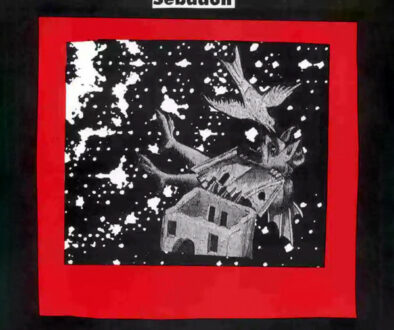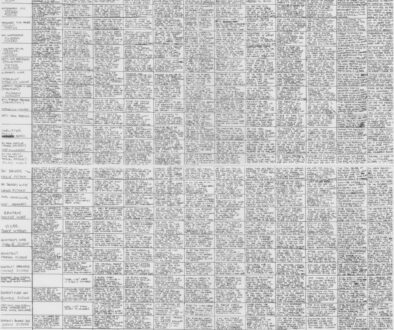Radical and Aggressive (Book Three, Part 35: Crawling From The Wreckage, Experimental Film)
Previously in The Last War in Albion: After finding success with Animal Man, Morrison was brought on to revitalize the floundering Doom Patrol comic, which they began by leaning hard into themes of trauma and mental illness.
“Religions are fictions that modify the world. It’s just that this fiction is more radical and aggressive.” – Alan Moore, Providence

Of course, Doom Patrol was at its core a superhero book, and it wouldn’t do to have it full entirely of fucked up people discussing their trauma. And so with the remainder of Crawling From the Wreckage, which transitions to a plot about the “Scissormen,” mysterious figures who speak in nonsense phrases like “The leaching will be novelistic for effacement! Curdle your pilgrimage! Curdle your pilgrimage!” and who cut people out of existence, leaving a white void where they’d been. This is inventive—a sly use of the two dimensional portrayal of comics, where cutting a character from the page makes obvious sense, that then gets extended to the imaginary third dimension that the characters occupy. These, it’s revealed, are creatures who came into existence with the composition of The Book With No Title, a book that describes the composition of a book called The Book With No Title, which is designed to alter human thought by introducing parasitic ideas, describing a city called Orqwith full of glass labyrinths and bone towers, that infiltrates other realities and slowly takes them over. Ultimately Rebis, Jane, and Roboman go to Orqwith where Rebis destroys it by addressing two clock-faced entities, one of whom always lies and the other of whom tells the truth, asking them “why is there something instead of nothing?”
This is a pleasant bevy of ideas, but astute and well-read readers will have recognized the central one as borrowed from Borges, specifically his story “Tlön, Uqbar, Orbis Tertius.” This story is structured much like a classical Lovecraft story, with a protagonist who investigates a mystery that leads inexorably towards a vast and reality-warping horror that drives him mad. It begins with the narrator, who purports to be Borges, learns about an aberrant version of an encyclopedia containing a description of an ancient city called Uqbar. Slowly Borges investigates, finding more information on Uqbar and its own fictional world of Tlön. Eventually it emerges that Uqbar and Tlön were created by a 16th century secret society as part of an elaborate plot to transform the world into a better version of itself by having Tlön slowly take it over, which, it’s revealed at the story’s end, it is doing so.

This is a clear swipe, though ultimately no more blatant than any number of swipes other writers have done. Crawling From the Wreckage is no clone of “Tlön, Uqbar, Orbis Tertius,” which lacks a terrifying city of bone, the Scissormen, or the accompanying theme of mental illness and trauma. But what is interesting about it is in many ways what Morrison doesn’t do, which is leave any sort of breadcrumbs leading the reader back to Borges. This is certainly not a problem—going down that road can lead easily to overstuffed stories that feel more like lectures than narratives. But it is perhaps surprising given Morrison’s larger approach. The book’s open embrace of weirdos and outcasts opens a clear angle to take on cool, weird, and hip influences like Borges in which the book presents itself as a sort of invitation to the subcultural—a one stop shop for the alienated weirdos of the late 80s/early 90s to find all the weird shit that previous generations of alienated weirdos made. Morrison would write a book along these lines in time, and it would be the most significant magical intervention of their career, but Doom Patrol isn’t it. Instead Morrison generally opts to file the serial numbers off their influences, so that the only name remaining attached to the ideas is their own. Instead of a book that brings readers into a set of larger intellectual and aesthetic traditions, it is a book that serves to make its writer look clever and interesting. This isn’t an inaccurate portrait of Morrison, and there’s a clear case to be made that proving it was a strong early career priority—it’s worth stressing that Doom Patrol #19 came out the same week as Animal Man #8, and that Morrison was still extremely early in their DC career and needing to make a name for themselves. And as noted, there are valid aesthetic goals to be had in not making the comic a lecture. More to the point, while Morrison generally obscured their influences, they didn’t always do it—there’s plenty of moments where Doom Patrol happily points readers towards cool shit they might enjoy. But as a general trend, Morrison prioritizes the establishment of their reputation, creating not a community of weirdos built around a shared set of references and signifiers but something more hierarchical, positioning themself as the cleverest of weirdos creating cool shit for all the other ones.
Morrison followed their initial arc with a pair of shorter pieces that served to continue setting up their basic approach to the book. The first of these was a two-parter whose A-plot featured an extradimensional villain named Red Jack who fed on pain and was convinced he was both God and Jack the Ripper. This had some interesting ideas, but its primary narrative focus was to briefly give some plot around the comatose Rhea, who Red Jack kidnaps, and thus more emphatically flag that Morrison still had some plans for her, most obviously when Red Jack alludes to “what she was becoming while she slept.” But the more significant element on the whole was the b-plot, which saw the arrival of Dorothy Spinner to the Doom Patrol.

Dorothy was a character who dated to the latter days of the Kupperberg run, first appearing in issue #14 as a minor character notable for her strangely simian appearance who gets named an “honorary” member of the Doom Patrol. Morrison resurrected the character—indeed Kupperberg’s final issue has her drawn in the background of the funeral scenes, although this ended up being an error given that Morrison instead had her walk into Doom Patrol headquarters at the start of issue #23 to join the team. Dorothy was the focus of issue #25, a one-shot that delves into her Gene Bomb-acquired superpower, the ability to manifest her imaginary friends in the real world. This is in many ways a troubled issue—Morrison crafts for her a psychosexual landscape centered around her anxiety and trauma over the onset of menstruation, a topic that proves no better for them than it did for Moore when he tackled it in Swamp Thing. On the bright side, the issue at least features the delightful beat of Dorothy proclaiming that she shot her imaginary friends with an imaginary gun after they began upsetting her. (Morrison, it turns out, nicked this from a conversation with their friend Emma.)

These first seven issues served to set the major pieces of Morrison’s run in place—there were a few things they’d add along the way, but the big strokes and major plot arcs were by this point present, and an essay in the back of their second issue makes it clear that they had the bulk of their run in mind from the start. (They describe having enough ideas to get to issue #60—in practice their run went to #63.) This essay also served as an opportunity for them to declare what they meant to do with the book. Much of this was frankly obvious—by the end of the second issue it was already clear that they intended to make the group weird again, for instance. More interesting were a couple of paragraphs in which they suggested the influence of a series of experimental filmmakers, starting with the Czech filmmaker Jan Švankmajer, plugging his first feature length film an Alice in Wonderland adaptation, which was at the time a current release. (Morrison advises readers that “if you get the chance to see it, jump at it.”) This is not, however, anything like a traditional take on the material—Švankmajer is miles from the accessible whimsy of the 1951 Disney film. His Alice is instead a deeply bizarre film that combines live action and stop motion animation, using fantastically disturbing puppets to tell the story. Its white rabbit, introduced early on in the film, is an uncomfortable and taxidermic creation with a visible rabbit jaw for a mouth, and every time it reaches into its body to check its watch it spills sawdust out from the gash in which it keeps it. Other characters are represented by animated skulls, giving the entire thing a distinctly ominous edge.
But while the disturbing imagery is the most immediately visible thing about Švankmajer’s Alice, it is not the most substantive. More remarkable is the extent to which the film strips out much of the dialogue, with what dialogue remains all being delivered by Alice, via extreme close-ups on her lips. This change heightens the sense of the weird within Carroll’s plot, emphasizing how strange the juxtapositions and basic concepts of the story are. As Švankmajer later put it, “So far all adaptations of Alice (including the latest by Tim Burton) present it as a fairy tale, but Carroll wrote it as a dream. And between a dream and a fairy tale there is a fundamental difference. While a fairy tale has got an educational aspect—it works with the moral of the lifted forefinger (good overcomes evil), dream, as an expression of our unconscious, uncompromisingly pursues the realisation of our most secret wishes without considering rational and moral inhibitions, because it is driven by the principle of pleasure.” And so his film is free to wander in these uncomfortable spaces, looking at Carroll’s story not as a fun and entertaining bit of Victorian whimsy but as something whose real meaning comes in its associations and implications—in the things it hints at, as opposed to the things it says.

In this regard it is the logical expansion of Švankmajer’s earlier short works such as Down to the Cellar, which depicted a young girl going into a basement to collect potatoes and encountering a series of strange and terrifying people and creatures like a woman baking little cakes out of coal and a bunch of cannibalistic shoes with teeth. There’s also Jabberwocky, which, though it contains a brief recitation of Carroll’s poem, is mostly concerned with a room full of objects coming to life, dancing around, and eventually descending into violence. In both cases the goal is to create the sense of a strange and dreamlike world, and to use this to explore the fears and psychology of childhood.

Švankmajer, however, was operating in a longer tradition of avant garde and experimental filmmaking, other parts of which Morrison also acknowledges, citing both Kenneth Anger and Maya Deren. In the former case, they cite his 1953 film Eaux d’Artifice, a thirteen minute film featuring a woman in period dress dancing amongst a garden full of fountains. This is presumably because Morrison was in the midst of writing the Red Jack arc that followed “Crawling From the Wreckage,” which uses similar imagery, but Anger would surely also have been on Morrison’s radar for the openly occult films that Anger made such as Inauguration of the Pleasure Dome, which featured Jack Parsons’ widow Marjorie Cameron, and Invocation of my Demon Brother, both of which explored Anger’s interest in Thelema. Both films worked through montage, creating a swirling juxtaposition of images that Anger used in order to craft his films into magic rituals unto themselves.

Morrison’s third example, Maya Deren, worked earlier than Švankmajer and Anger, doing her best work in the 1940s. Morrison cites Meshes of the Afternoon, a silent film in which she also stars, which depicts a dream that gradually fragments, so that versions of Deren watch other versions of her going through their prescribed parts of the dream, creating an ever denser web of symbolic actions. Morrison, writing in a 1993 essay for Rapid Eye (which, intriguingly, opens with a mention of having just consumed a bunch of hash in Kathmandu), describes it as being “filled wall-to-wall with off-the-peg Freudian furnishings—open purses, locks and keys, broken mirrors, knives—but somehow she makes it work and actually succeeds in pinning a raw, wet dream up there on the scream as though she’d managed to sneak a camera inside her head and get it back out again, having captured some breathing part of that luminous uncertain world we abandon ourselves to every night.”
Of these influences only Deren ever becomes overt—the painting Jane is working on in her first appearance is “a picture of Maya Deren at the moment of her death, possessed by Maîtresse Erzulie”—and Morrison’s plots are generally more concrete than these, famously out of control as they can sometimes get. But Morrisons stated plan to “bring some of that dream-like ambience” to Doom Patrol makes sense, and is visible from the start in the strange juxtapositions that make up Orqwith. Much like the films that influenced it, Doom Patrol under Morrison was a comic that was not afraid of not “making sense” as traditionally understood. And yet there is just as obviously peril here. Švankmajer, Anger, and Deren made extraordinarily weird films, but their weirdness was always in service of a clear point. They had things they wanted to say, and those things—strange horrors of childhood, mystical experiences, and subconscious dreams—could only be expressed in strange ways.





January 10, 2022 @ 10:46 am
Thus also linking right into Smullyan and Hofstadter, two more major solaces of nerd-brained alienated weirdos of the late 80s.
January 10, 2022 @ 10:58 am
Fear not, we’ll get there.
January 10, 2022 @ 3:05 pm
Reclaiming Jane’s idiographic “logo” for the dp and then tilting it (ϕ=ø) in the Dorothy caption is absolutely sublime.
January 13, 2022 @ 2:21 am
I think Imaginary Friends is much less about menstruation than Moore’s werewolf story. (Mind, it would be hard to be /more/ about menstruation.) The blood imagery is only on a couple of pages, and the big reveal occupies just two panels. I think it’s really about the transition from childhood to adolescence, and how childhood fears, if not dealt with, can blossom into neuroses and mental illness.
Remember, all through Morrison’s run Dorothy will be presented as sane. She’s young, she’ll make mistakes, and one mistake in particular will have gruesome consequences. But she’s emphatically not mentally ill.
Also: here we see something Morrison will do repeatedly, which is to have a sort of hierarchy of straight men. There are characters who are so weird they need interpretation, like Rebis. Then there are characters that are weird but can somewhat explain themselves, like Jane and the Chief. These characters need someone to explain themselves to, so they need a straight man. Robotman / Cliff most frequently fulfills this role — so frequently, in fact, that the Chief calls him out on it a couple of times. But sometimes Cliff himself is the weird one in the room, and then Dorothy or Joshua will fulfill the straight man role. (Joshua is such a straight man that Morrison is pretty clearly bored with him.)
Anyway: I do think there’s a bit more to say about the first story arc. Morrison does a very good job introducing the characters and hitting the mandatory “show their super powers” beats. Pitting them against a bunch of identical mooks with poorly defined powers makes perfect sense here. (And then, since the mooks are visually identical, making them interesting through weird-ass dialogue. That is just damn clever.)
Even though it’s very early in his DC career, he’s already very comfortable with the medium; in terms of dialogue, plot, beats, and layout, he’s long past the journeyman stage. Putting aside the weirdness and all, Morrison is a really good comic book writer. That matters a lot!
Finally, here’s a thing that afaik I am the only person to notice and comment upon: Red Jack’s design owes much to the animated movie version of the Terrible Trivium in The Phantom Tollbooth. Like Jack, the Trivium is a well-dressed, well-spoken character with a featureless blank for a face, and with empty space where his neck, wrists, and ankles should be — his head, gloved hands and shoes just float in air, not physically connected to his body. That’s an extremely specific character design. IDK if it was Morrison’s idea or Case’s, but anyway I think I’m the only one who’s ever publicly noted the connection. If I’m wrong and someone else did already, I welcome correction.
Here I’ll note that, like Alice, The Phantom Tollbooth is about a child’s journey to an imaginary world. It’s much more didactic — a fairy tale, Svankmajer would say, rather than a dream. But it’s nearly as surreal as Alice, and occasionally terrifying. And it also grapples with issues of mental illness, or at least of neurosis and depression, in a way that Alice doesn’t. Several of the Tollbooth’s characters, like Tock or The Humbug, would fit in with the Doom Patrol just fine.
Doug M.
January 16, 2022 @ 2:52 am
Oh, and: Red Jack’s outfit is the White Rabbit’s outfit from the Svankmajer film, minus the hat. I just rewatched it, and you see it very clearly in the scene where the rabbit dresses itself.
Doug M.
January 18, 2022 @ 7:07 pm
I wrote a college essay on the connections between Crawling From the Wreckage and the Borges story, since we were studying Borges. I wonder if it’s still around